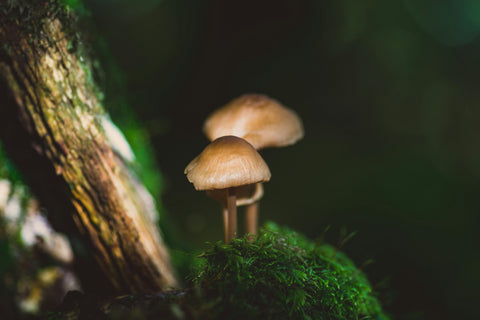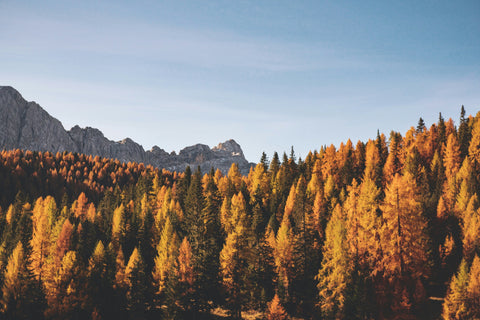When autumn rolls in, with crisp air, damp leaves, and that earthy scent of renewal, it’s not just the trees preparing for change. Beneath our boots, the forest is quietly awakening.
Hidden in the soil, fungal networks, or mycelium, sense the shift. A drop in temperature here, a touch of moisture there, and suddenly mushrooms emerge overnight like notes rising in a silent song.
For fungi, this isn’t magic. It’s timing, a masterclass in responding to environmental cues.
According to researchers from the University of Oxford and long-term studies on fungal phenology, fungi reproduce most successfully in autumn, when the world above and below ground is perfectly tuned to their needs.
Much like how PlantChoir listens to the subtle bio-signals of houseplants and translates them into music, fungi “listen” to their environment in their own way, waiting patiently for the perfect tempo of moisture and temperature to begin their grand performance.
The Environmental Cues of Fungal Awakening

Temperature and Moisture: The Conductors of the Underground Orchestra
Autumn’s cooler temperatures and increased rainfall create ideal conditions for fungal fruiting bodies, mushrooms, to emerge.
During dry, hot summer months, the mycelium network lies mostly dormant, storing energy and waiting. But when the air cools and rain softens the soil, these underground threads come alive with activity.
Moisture is the key that unlocks this process.
Fungal spores can remain inactive for months until humidity and soil wetness reach the right threshold. Once awakened, they germinate, connect through hyphae, and begin producing fruiting bodies, those curious caps and stems we spot on forest walks.
It’s a delicate balance. Too dry, and fungi stay hidden. Too cold, and they stall. But autumn offers the sweet spot: just enough warmth for growth, just enough moisture for life.
Sensing the Shift: Fungi as Environmental Listeners

If you think fungi are passive, think again.
They have evolved sophisticated sensory systems that detect minute changes in soil temperature and water content. Mycologists such as Dr. Peter Moore describe this as an adaptive intelligence, fungi “read” their surroundings through biochemical responses, switching from quiet vegetative growth to reproductive vigor when the signals align.
Some even compare this sensitivity to the way plants respond to light and sound.
Fungi, however, work underground, feeling rather than seeing. They sense vibration, moisture, and even electrical gradients across their mycelial networks. It’s a kind of biofeedback loop that guides them toward reproduction when conditions promise success.
If you’ve ever used PlantChoir, you’ve experienced a similar kind of listening, turning invisible bioelectric signals into sound. Both systems remind us that the natural world is never silent. It’s humming with quiet communication.
Why Autumn Is the Perfect Season

A Season of Decay and Renewal
Autumn is a season of endings, but for fungi, it’s the season of opportunity.
As leaves fall and organic matter begins to decay, fungi step in as nature’s recyclers. They break down cellulose and lignin from fallen branches, turning death into nourishment for the soil.
This synchrony with the plant world is no accident. Leaf drop coincides with fungal fruiting, ensuring a feast of material for decomposers. The timing is evolutionary perfection, an ecological duet that keeps forest ecosystems in balance.
According to long-term ecological studies, climate change has started to shift these delicate rhythms. Warmer autumns and irregular rainfall patterns are altering fruiting times for many species, compressing what was once a months-long season into a few short weeks.
The forest calendar is changing, and fungi are adapting, sometimes fruiting later than ever before.
Early, Mid, and Late Autumn Performers
Just as an orchestra introduces its players one by one, different fungi appear in a seasonal sequence.
Early Autumn:
Boletes and russulas are among the first to emerge, often popping up in late summer when rains return. Vibrant and meaty, they thrive on the first cool nights of September.
Mid-Autumn:
Classic agarics (the typical cap-and-stem mushrooms) and fairy rings come next, reveling in October’s steady dampness. Polypores and bracket fungi begin their slow growth on fallen trunks.
Late Autumn:
By November, the forest belongs to the cold-lovers. Pathogenic tree fungi and seasonal polypores take over, feeding on deep wood layers as frost creeps in. Their fruiting extends the cycle until winter silences the soil again.
This succession ensures that decomposition and nutrient cycling continue seamlessly from summer’s end into winter’s rest, a biological choreography tuned by temperature and moisture.
The Science of Reproductive Timing

Temperature as a Trigger
For many fungal species, the drop in temperature signals a shift from vegetative growth (mycelium expansion) to reproduction (mushroom fruiting).
It’s similar to how some plants use day length, or photoperiod, to decide when to bloom.
In fungi, cooler soil prompts the expression of specific genes that regulate fruiting body formation. These genetic switches ensure the mushroom appears only when it has the best chance of survival and spore dispersal.
Moisture as the Fuel
Without moisture, no mushroom can rise.
Spores and hyphae require a thin film of water to grow and connect. High humidity keeps developing mushrooms from drying out, a crucial factor for spore maturity and release.
Even the structure of a mushroom reflects this need: the gills or pores beneath the cap are designed to maximize surface area for spore dispersal in moist air. When the environment dries, spore release stops almost immediately.
Weather Windows: The Perfect Fruiting Moment
Research shows the most productive mushroom “flushes” occur after a pattern of warm, wet weeks followed by cool, moist days.
Soil temperature, air humidity, and rainfall combine like musical notes to form the ideal chord.
In short:
-
Warmth encourages mycelium expansion underground.
-
Moisture triggers fruiting body development.
-
Cool nights preserve the fruit and aid spore release.
It’s no wonder mushroom hunters wait for those misty, mild mornings after a few days of rain, the exact conditions fungi have been waiting for all year.
Edible Fungi and Their Autumn Calendar
Fungi may seem mysterious, but their patterns are beautifully consistent.
Here’s when you’ll likely find some of the most beloved edible species in temperate regions
| Mushroom | Typical Fruiting Time | Notes |
|---|---|---|
| Chanterelles (Cantharellus cibarius) | Early Autumn | Peak in late summer–September, before frost |
| Chicken of the Woods (Laetiporus sulphureus) | Early–Mid Autumn | Starts around September; bright orange and abundant before frost |
| Hen of the Woods / Maitake (Grifola frondosa) | Early–Mid Autumn | Grows at hardwood tree bases, Sept–Oct |
| Oyster Mushroom (Pleurotus ostreatus) | Late Autumn | Best in Oct–Nov; thrives in cool damp air |
| Yellowfoot (Craterellus tubaeformis) | Late Autumn | Fruits late fall into winter; cold-hardy |
| Hedgehog Mushroom (Hydnum repandum) | Late Autumn | Fruits after frost, through early winter |
These shifts are remarkably consistent across North America and Europe, though climate and local weather can move the schedule forward or back by a few weeks.
Fungi, Forests, and the Language of Life
Beyond fruiting times, fungi are the quiet architects of ecosystems.
Their networks connect plants, trees, and soil organisms in what’s often called the “wood wide web.” Through mycorrhizal relationships, fungi exchange water, nutrients, and even chemical signals with trees.
In autumn, this network is especially busy. As trees draw down their sugars and shed leaves, fungi receive a last infusion of energy, fuel for the coming fruiting season. In return, they recycle nutrients back into the soil, feeding the next year’s growth.
It’s a living cycle of communication, one that echoes the feedback loops you can actually hear through a device like PlantChoir, where plant bio-signals become musical tones.
Listening to a plant’s “song” while surrounded by mushrooms after rainfall can be a deeply meditative experience. It’s as if nature’s hidden voices align in harmony.
A Changing Climate, A Shifting Symphony
Long-term studies in fungal ecology reveal that mushroom seasons are changing.
Early-fruiting species now appear later than they did decades ago, and the overall autumn fruiting season has become more compressed.
The culprits? Warmer nights, less predictable rainfall, and disrupted soil moisture cycles.
But fungi are adaptable. Some species extend their range northward or shift fruiting to cooler months. Their timing, like their music, is always adjusting to the rhythm of the earth.
How to Experience the Magic Yourself
You don’t have to be a mycologist to notice these changes or enjoy the fungal season.
Here’s how to tune in to the rhythms of autumn fungi:
-
Walk after rain. Fungi emerge within 24–48 hours of sustained moisture.
-
Look low and slow. Check under leaves, near tree roots, and in shaded mossy areas.
-
Observe without harvesting. Many mushrooms are protected or vital for local ecosystems.
-
Listen to the landscape. Bring your PlantChoir device and connect it to a nearby fern or houseplant back home. Compare how your plants “sing” after rain, it’s a beautiful way to sense environmental change.
-
Journal your findings. Track when and where you see mushrooms. Over time, you’ll start to notice how local climate patterns influence fruiting.
How it works: PlantChoir overview • Setup tutorial • Use cases at home and events
Listening to Autumn’s Hidden Symphony
The story of fungi in autumn isn’t just about reproduction, it’s about rhythm, response, and connection.
Every mushroom that rises from the soil represents a dialogue between organism and environment. The drop in temperature, the scent of damp earth, the hum of decaying leaves, all become cues in a vast biological composition.
Much like how PlantChoir translates a plant’s inner world into music, fungi translate the season’s environmental signals into form.
Both invite us to listen, not just with our ears, but with curiosity and care.
So this autumn, when you notice mushrooms scattered like quiet notes on the forest floor, pause and imagine the unseen orchestra below.
It’s nature’s most ancient performance, playing in perfect time with the turning year.
Try PlantChoir today
and discover how your own plants respond to the changing seasons.
Listen to their biofeedback music and feel the rhythm of nature, alive, adaptive, and beautifully in tune.
![]()
References
The Conversation – Why Autumn Is the Best Time to See Fungi
ScienceDirect – Climate Effects on Mushroom Phenology
Ruissalo Info – Hiding Fungi Pop Into View in Autumn
Garden Professors – Fall Is for Fungal Fruit
Lukas Guides – Fall with Spores
Wild Foods – Get to Know Autumn Mushrooms
PMC – Long-Term Fungal Phenology Studies
![]()



